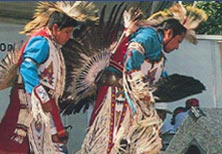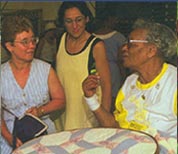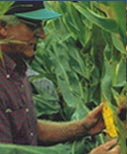|
|
Lesson 4.1: Quilting Communities
|
|
| Questions to be Answered |
| Why are quilts important? |
| Are there different cultural/aesthetic styles for making quilts? |
|
- Read the descriptions of quilting in the handout and discuss how and why the women learned to quilt. Discuss the similarities and differences in their quilt patterns.
- Have students draw their own quilts or quilt blocks based upon the sample designs in the handout.
- Discuss with students changes over time in color, pattern, and material preferences that have affected quilting (e.g., cotton to polycotton blends; use of calico prints, flour sacks, plaids, etc.; popularity of different quilt patterns—double wedding ring, Holly Hobby, bow-tie, etc.).
- Have students experiment with the designs, changing patterns and color schemes. Have a discussion about whether the changes might be recognizable as part of the tradition—or aesthetically too far afield from it.
- Choose one particular design and have students sew blocks for a quilt that can be put together (non-quilting teachers should probably contact the local quilters guild or a knowledgeable parent or senior for help in putting the blocks together).
- Have students design and draw their own quilt blocks for three or four specified reasons (a birth, a wedding, friendship, other event). Students should attach a brief written description of what their block means, and why a particular color or pattern was selected.
- Have students interview a quilter in their family or neighborhood. Compare the reasons for quilting, the way it was learned, the context for quilting with the profiles provided in the handout.
HIGH SCHOOL ADDITIONS: Discuss with students the importance of marking special occasions with handmade objects. Why do we commemorate special events? Discuss why the AIDS quilt has become such a moving symbol for the creators, viewers, and for those it commemorates. Design a quilt that might be appropriate for the school or home-town community.
- Ask students to bring in family quilts for display and find out from family members the history of the quilt.
- Check out the Iowa Folk & Traditional Arts Roster or contact your local Iowa Quilters Guild to invite a quilter into your classroom to demonstrate quilting skills to students
Many of the women and some of the men in senior centers have been or still are quilters. They can be wonderful resources for teaching quilting and taking part in oral history sessions. Seniors might also enjoy displaying their family quilts to students and talking about their meaning and significance.
| |
| |
|
Photo |
|
|
|
| |
LESSON 4.1 |
|
| Frances Brewton instructs children at the Smithsonian Festival on quilting techniques. What challenges did Mrs. Brewton face in learning how to quilt? |
| |
|
PHOTO BY RICHARD STRAUSS |
|
|
|
|









